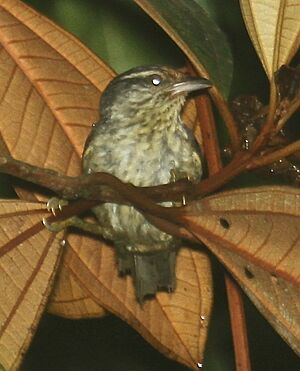Equatorial greytail facts for kids
Quick facts for kids Equatorial greytail |
|
|---|---|
 |
|
| Conservation status | |
| Scientific classification | |
| Genus: |
Xenerpestes
|
| Species: |
singularis
|
 |
|
The equatorial greytail (Xenerpestes singularis) is a small, unique bird. It's a type of ovenbird, which belongs to a family of birds known for their interesting nests. You can find this bird in the beautiful Andes mountains of Ecuador and Peru. It's currently considered a Near Threatened species, which means its population needs careful watching.
Contents
About the Equatorial Greytail
The equatorial greytail is the only species in its group, making it "monotypic." It shares its genus, Xenerpestes, with another bird called the double-banded greytail. These two birds are like close cousins to the orange-fronted plushcrown.
What Does It Look Like?
The equatorial greytail is a tiny bird, only about 11.5 cm (4.5 in) long. It weighs around 12 g (0.42 oz), which is about as much as a few paper clips! It looks a bit like a warbler. Both male and female birds look the same.
Adult greytails have a grayish face with some buffy (pale yellowish-brown) spots near their eyes. They have a thin, light stripe above their eyes called a supercilium. The front part of their head is reddish-brown with black streaks. The back of their head, their back, and their tail are olive-gray. Their wings are dark, with gray-brown feathers and thin brown edges on the flight feathers.
Their belly and chest are creamy white with blurry gray streaks. Their eyes are gray-brown. Their beak is dark gray to black on the top part and creamy to pale gray on the bottom part. Their legs and feet are olive-brown. Young greytails look similar but have gray bars instead of streaks on their undersides.
Where Does It Live?
The equatorial greytail lives in the foothills of the eastern side of the Andes mountains. You can find it in Napo Province in Ecuador and a little bit into northern Peru.
It prefers to live inside and along the edges of humid montane forest, which are forests found in mountainous areas. In Ecuador, it lives at heights from 1,000 to 1,600 meters (3,300 to 5,200 ft) above sea level. In Peru, it lives a bit higher, from 1,050 to 1,700 meters (3,440 to 5,580 ft).
Behavior
Movement
The equatorial greytail is a "resident" bird. This means it stays in the same area all year long and does not migrate to other places.
Feeding Habits
This bird loves to eat arthropods, which include insects and spiders. It looks for food high up in the forest, in the subcanopy (the layer of trees below the main canopy) and the canopy (the very top layer of trees).
It forages alone, in pairs, or in small family groups. It often joins mixed-species feeding flocks, which are groups of different bird species feeding together. The greytail picks prey from both live and dead leaves. Sometimes, it even hangs upside down to get food from the underside of leaves! It also finds food on small branches and twigs.
Reproduction
The equatorial greytail seems to start building its nest in January. Its nest is a large ball made of sticks, hanging from a tree branch. Scientists don't know much more about how these birds raise their young.
Vocalization
The song of the equatorial greytail is a long, dry, and almost insect-like sound. It's like a reeling trill that lasts for five seconds or more, sounding like "tzzzzzzzzzzzzzzzz." Its call is a short, dry "tsit."
Status and Conservation
The IUCN (International Union for Conservation of Nature) has listed the equatorial greytail as "Near Threatened." This means that while it's not in immediate danger, its population is decreasing and needs close monitoring.
The bird is rare and found only in specific areas within its limited range. The exact number of these birds is unknown, but it's believed to be shrinking. Its home, the montane forest, is facing many threats. People are clearing these forests to create farms for crops and cattle. Mining and logging also cause widespread destruction. This loss of habitat is a big problem for the equatorial greytail.


